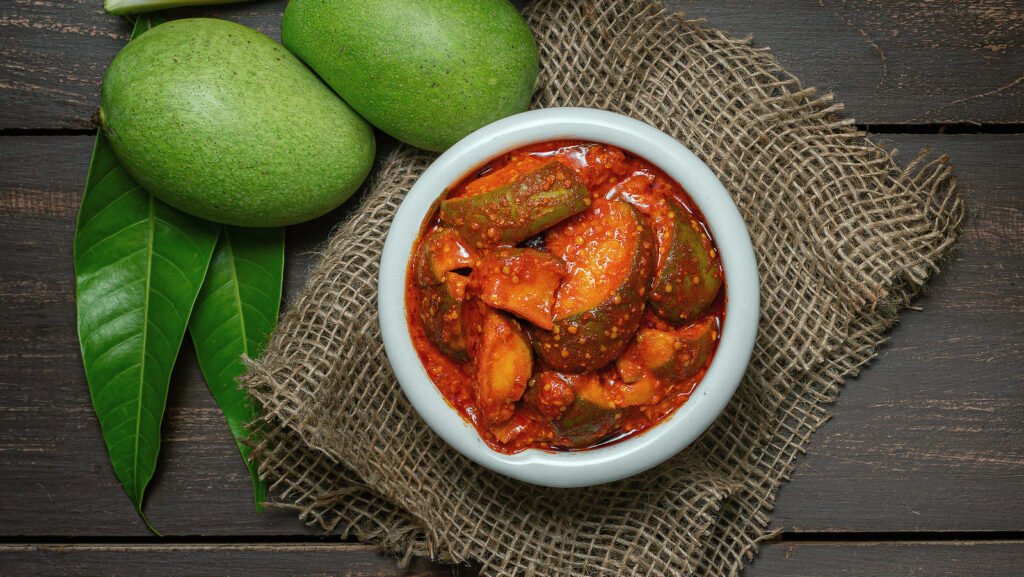How to Make Mango Pickle – A Traditional Delight

Introduction
Mango pickle, a vibrant and flavorful accompaniment in many cuisines, especially in South Asia, is an amalgamation of tang, spice, and all things nice. This post is your comprehensive guide to making traditional mango pickle at home, complete with step-by-step instructions, precautions, and answers to frequently asked questions.
The Cultural Significance of Mango Pickle
In many parts of the world, mango pickle is not just a condiment but a cherished part of culinary heritage. Originating from the Indian subcontinent, this delightful pickle has found its way into hearts and kitchens globally. Each region has its unique twist to the recipe, reflecting the diversity of cultures and tastes.
Ingredients
- Raw mangoes: 1 kg
- Mustard oil: 250 ml
- Fenugreek seeds: 2 tbsp
- Fennel seeds: 3 tbsp
- Red chili powder: 2 tbsp
- Turmeric powder: 1 tbsp
- Asafoetida (Hing): 1 tsp
- Salt: to taste
Equipment Needed
- Large mixing bowl
- Sterilized glass jars
- Dry, clean spoon
- Stovetop and pan
Step-by-Step Guide to Making Mango Pickle
1. Preparation of Mangoes
Begin by thoroughly washing the mangoes. Dry them completely and cut into small, uniform pieces. The key is to ensure no moisture remains as it can lead to spoilage.
2. Roasting and Grinding Spices
Roast fenugreek and fennel seeds lightly and grind them. This enhances the flavors and gives your pickle an authentic taste.
3. Mixing Ingredients
In a large bowl, mix the cut mangoes with the ground spices, red chili powder, turmeric, asafoetida, and salt. Ensure the mangoes are well-coated.
4. Storage and Fermentation
Transfer the spice-coated mangoes into sterilized jars. Heat mustard oil until smoking and allow it to cool. Pour this over the mangoes in jars, ensuring the mangoes are completely submerged. Store in a dry, warm place for fermentation.
Precautions and Tips
- Sterilize all equipment to prevent microbial growth.
- Use high-quality mustard oil for authentic flavor and preservation.
- Adjust the amount of chili and salt as per taste.
- Ensure the mangoes are completely dry before cutting.
- Store in a cool, dry place away from direct sunlight.
FAQs
1. How long does homemade mango pickle last?
Answer: If stored properly, homemade mango pickle can last up to a year.
2. Can I use a different oil instead of mustard oil?
Answer: Yes, but mustard oil gives a traditional flavor and natural preservative qualities.
3. What are the best mangoes for pickle-making?
Answer: Firm, raw mangoes are ideal for pickling as they hold their shape and absorb flavors well.
4. How do I know if my pickle has fermented properly?
Answer: The mangoes will soften slightly, and the oil will have a rich, aromatic smell indicating proper fermentation.
5. Is it necessary to add preservatives?
Answer: No, the oil and spices act as natural preservatives.
6. Can I make mango pickle without using asafoetida?
Answer: Yes, though asafoetida adds a unique flavor, it can be omitted or substituted with garlic or onion powder.
7. How should I store the pickle?
Answer: Store in a cool, dry place, away from direct sunlight. Refrigeration is not necessary but can extend shelf life.
8. Can I speed up the fermentation process?
Answer: Fermentation is a slow process and speeding it up can alter the flavors. Patience is key.
9. Why is my pickle too salty/spicy?
Answer: This can happen if the proportions are not balanced. Adjust the levels in your next batch.
10. Is mango pickle healthy?
Answer: In moderation, mango pickle is a good source of vitamins A and C, but it is high in sodium.

Conclusion
Mango pickle, with its rich heritage and robust flavors, is more than a mere side dish; it’s a celebration of traditions and tastes. The process of making it at home allows for personalization and ensures a fresh, preservative-free experience. Enjoy your homemade mango pickle as a condiment with meals, as a flavor enhancer, or simply relish it as a tangy, spicy snack!
Similar blog posts are continuously uploaded on our website Airynews.com. For more details click here.





